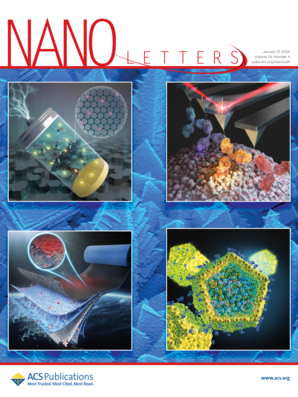金刚石分子平衡:从MDa到TDa的超宽范围纳米机械质谱分析
IF 9.6
1区 材料科学
Q1 CHEMISTRY, MULTIDISCIPLINARY
引用次数: 0
摘要
质谱法的意义在于其无与伦比的准确识别和定量复杂样品中的分子的能力,为分子结构和相互作用提供了宝贵的见解。在这里,我们利用金刚石纳米结构作为高灵敏度的质量传感器,在传统的扫描电子显微镜(SEM)中利用电子束下的自激机制。基于其显著的机械品质因子和频率稳定性,以及从MDa到TDa的广泛动态范围,金刚石分子平衡(DMB)具有4.07 MDa的实际质量分辨率。这使得DMB处于室温下纳米机电系统(NEMS)质谱分析的前沿。值得注意的是,DMB通过精确定位设备上的分析物,证明了其测量单个噬菌体T4质量的能力。这些发现证明了DMB作为室温质谱分析的革命性工具的能力和潜力。本文章由计算机程序翻译,如有差异,请以英文原文为准。

Diamond Molecular Balance: Ultra-Wide Range Nanomechanical Mass Spectrometry from MDa to TDa
The significance of mass spectrometry lies in its unparalleled ability to accurately identify and quantify molecules in complex samples, providing invaluable insights into molecular structures and interactions. Here, we leverage diamond nanostructures as highly sensitive mass sensors by utilizing a self-excitation mechanism under an electron beam in a conventional scanning electron microscope (SEM). The diamond molecular balance (DMB) exhibits a practical mass resolution of 4.07 MDa, based on its notable mechanical quality factor and frequency stability, along with a broad dynamic range from MDa to TDa. This positions the DMB at the forefront of nanoelectromechanical system (NEMS)-based mass spectrometry operating at room temperature. Notably, the DMB demonstrated its ability to measure the mass of a single bacteriophage T4 by precisely locating the analyte on the device. These findings demonstrate the capability and potential of the DMB as a revolutionary tool for mass spectrometry at room temperature.
求助全文
通过发布文献求助,成功后即可免费获取论文全文。
去求助
来源期刊

Nano Letters
工程技术-材料科学:综合
CiteScore
16.80
自引率
2.80%
发文量
1182
审稿时长
1.4 months
期刊介绍:
Nano Letters serves as a dynamic platform for promptly disseminating original results in fundamental, applied, and emerging research across all facets of nanoscience and nanotechnology. A pivotal criterion for inclusion within Nano Letters is the convergence of at least two different areas or disciplines, ensuring a rich interdisciplinary scope. The journal is dedicated to fostering exploration in diverse areas, including:
- Experimental and theoretical findings on physical, chemical, and biological phenomena at the nanoscale
- Synthesis, characterization, and processing of organic, inorganic, polymer, and hybrid nanomaterials through physical, chemical, and biological methodologies
- Modeling and simulation of synthetic, assembly, and interaction processes
- Realization of integrated nanostructures and nano-engineered devices exhibiting advanced performance
- Applications of nanoscale materials in living and environmental systems
Nano Letters is committed to advancing and showcasing groundbreaking research that intersects various domains, fostering innovation and collaboration in the ever-evolving field of nanoscience and nanotechnology.
 求助内容:
求助内容: 应助结果提醒方式:
应助结果提醒方式:


